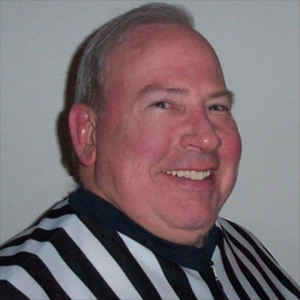
Rndballref
20 Years Experience
Chicago, IL
Male, 60
For twenty years I officiated high school, AAU and park district basketball games, retiring recently. For a few officiating is the focus of their occupation, while for most working as an umpire or basketball referee is an avocation. I started ref'ing to earn beer money during college, but it became a great way to stay connected to the best sports game in the universe. As a spinoff, I wrote a sports-thriller novel loosely based on my referee experiences titled, Advantage Disadvantage
There is no provision in the NFHS book which grants disputes between referees except that the official designated as the "referee" (as opposed to official 1 and 2) has the responsibility to resolve uncovered issues.
When two referees disagree, the way it should work is as follows: Official 1 makes a call. Official 2 sees it a different way and the two officials privately discuss it. Official 1 needs to be convinced. If official 1 decides official 2's call is the correct one, then official 1 should signal the correct call, and be prepared to defend it with the coaches.
When the ball goes through the basket it is a dead ball and anyone can call timeout until the team takes possession (even after a made basket by your team while on offense, until your opponent picks up the ball).
After the first of 2 free throws there will not be team possession, so either team can call time out until the ball is at the disposal of the shooter for his second free throw.
Rule 7 in the NFHS rule book is the chapter on Out of Bounds and The Throw In. Section 1, Article 2b states, "The ball is out of bounds when it passes over a rectangular backboard. By excluding fan shaped backboards it means a ball passing over fan shaped is NOT out of bounds.
According to theriches.com beginning NBA referees make $150,000 and senior officials make up to $550,000. In every game, one official is designated as the "referee" and the others are "officials". In NFHS, the referee has certain additional duties such as picking who will toss jump balls, giving pre-game instructions etc.. But the "referee" is not supposed to overrule the other two officials. I suspect that in the NBA, senior officials might have additional duties such as travel arrangements, meetings, training, rule advisories, etc.
TV Meteorologist
 What were your worst on-screen bloopers?
What were your worst on-screen bloopers?
Parcel Delivery Mailman
 Are you a lot stronger and more fit because of your job?
Are you a lot stronger and more fit because of your job?
Veterinarian
 How do you break the news to a kid when his pet dies?
How do you break the news to a kid when his pet dies?
Here's the jump ball rule: Neither jumper shall 1) touch the ball before it reaches its height, 2) leave the circle until the ball has been touched, 3) catch the jump ball, or 4) touch the ball more than twice.
These restrictions are in place until: the ball contacts one of the eight non-jumpers, an official, the floor, a basket or the backboard.
In youth basketball it is common to be biased against the biggest kids. It is unfair, but it happens. If there is a silver lining it is that your son will be well prepared for AAU and high school rough play. Although unfair, it is better for your son to toughen up then for him to not develop because he is currently bigger than his teammates. Read the book, "Play Their Hearts Out" for a real story of the next LeBron who was the best player in the country in middle school, but flattened out at 6'2" as a senior in high school.
The ball is always awarded to the team opposite of the one who touches the ball last. The rim or backboard does not erase the last person to touch the ball. So in your question the defensive player is the last to touch the ball (ever so slightly) and the ball goes back to the shooter's team.
-OR-
 Login with Facebook
Login with Facebook (max 20 characters - letters, numbers, and underscores only. Note that your username is private, and you have the option to choose an alias when asking questions or hosting a Q&A.)
(A valid e-mail address is required. Your e-mail will not be shared with anyone.)
(min 5 characters)
By checking this box, you acknowledge that you have read and agree to Jobstr.com’s Terms and Privacy Policy.
-OR-
 Register with Facebook
Register with Facebook(Don't worry: you'll be able to choose an alias when asking questions or hosting a Q&A.)